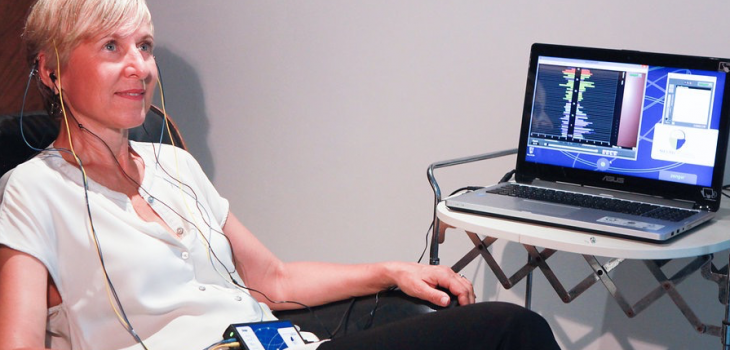What is Neurofeedback?
Neurofeedback is a treatment method for brain-related disorders, such as burnout, sleep problems, restlessness, chronic pain, depression and ADHD/ADD.Every brain produces brain waves. These brain waves enable communication between different areas of the brain. Just like blood pressure and heart rate, these waves must fall within certain values. When brain waves fall outside these values, the different areas of the brain communicate inefficiently with each other. Your brain is, as it were, out of balance. This can lead to psychological and/or physical complaints.

How does neurofeedback therapy work?
Neurofeedback is used to correct an imbalance in brain waves through targeted training. The aim is to achieve greater balance in the brain waves. This leads to better cooperation between the different areas of the brain. The ‘teamwork’ improves, like an orchestra that works better together and produces fewer false notes. During the treatment, the brain waves are measured using an EEG. At the same time, you listen to music or watch a film. The neurofeedback system observes the brain waves. In the event of deviations, the system briefly interrupts the music or film. The interruption is so short (milliseconds) that you do not consciously notice it, but subconsciously you get neurology so feedback about any deviations. In this way, the brain learns to regain its balance on its own.
Our approach
We work with the most common method in the Netherlands: the Zengar (also known as NeurOptimal) method. Practices affiliated with the Dutch Association for Neurofeedback all work with this method.
The first treatment is an intake and session together. This takes approximately 1.5 hours. Subsequent treatments take approximately one hour.
At the start of the treatment, we take an initial measurement. Then the treatment begins. You sit in a chair and listen to music. All you have to do is relax. Afterwards, we take a follow-up measurement.
After the treatment (and in the days following), you may feel somewhat tired. This is usually experienced as a pleasant tiredness, similar to how you feel after going to the gym. The brain is, in fact, also a type of muscle.
Who is neurofeedback suitable for?
Many mental disorders stem from irregularities or imbalances in brain waves. This makes neurofeedback a treatment method that can be used in a wide variety of situations. The training is suitable for both children and adults, young and old.
How many sessions will I require?
The rule of thumb is a minimum of 10 sessions to arrive at an initial assessment of progress. In most cases, clients experience results sooner. However, it is important to continue training so that the brain completes the learning cycle.
The interval between sessions usually becomes longer. It is not unusual for a follow-up session to take place after two weeks or even a month. However, every person is different and every treatment plan is therefore personalised.
Training brain waves using neurofeedback can ultimately be seen as similar to learning to ride a bicycle. Once the brain has learned the trick, it never forgets it. The results achieved are therefore permanent.
Who is your conversation partner?

Tim Brinkman
Our rates
Intake and session
- The intake and first session together last between one hour and a maximum of 1.5 hours.
- The treatment is performed by Tim Brinkman.
